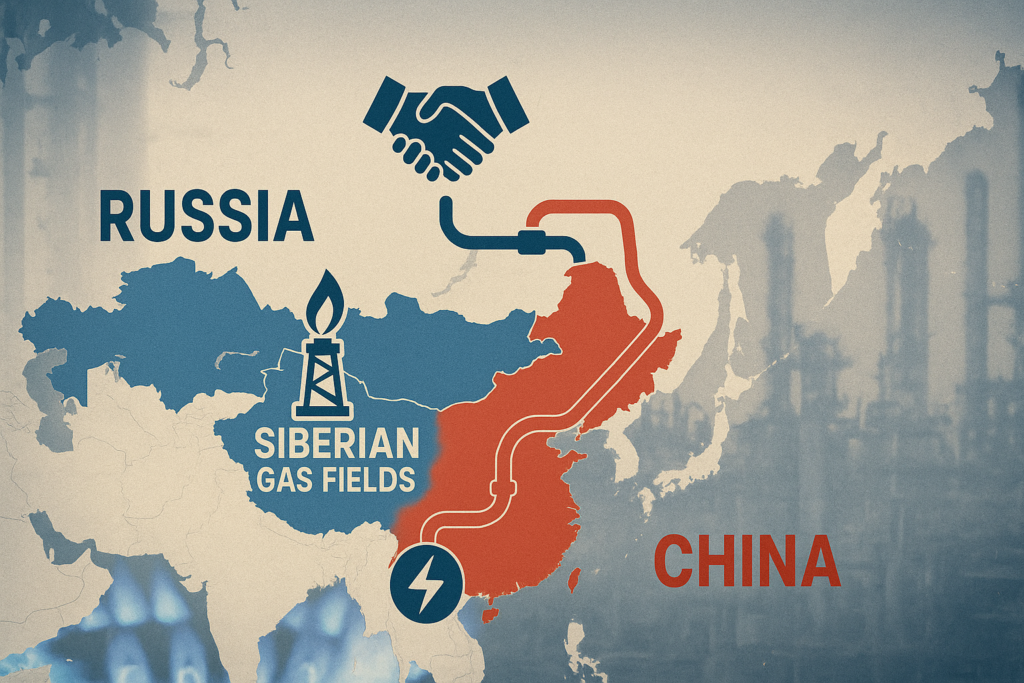Key Highlights
- Massive Scale Agreement: Power of Siberia 2 pipeline will deliver 50 billion cubic meters (bcm) of natural gas annually for 30 years from Russia’s Arctic Yamal fields to China via Mongolia transit route
- Expanded Energy Partnership: Total Russian gas exports to China could reach 106 bcm annually, with existing Power of Siberia capacity increased from 38 to 44 bcm and Far Eastern Route from 10 to 12 bcm
- Strategic Geopolitical Pivot: Agreement signed during Shanghai Cooperation Organisation (SCO) summit in Beijing, cementing “no limits” partnership as Russia seeks Asian market alternatives to European sanctions
- Financial and Commercial Terms: While legally binding memorandum signed, pricing and timeline details remain under separate negotiation, though gas prices for China will be lower than European rates due to shorter transport distances
- Global Energy Realignment: Deal signals fundamental shift in global energy order as Europe moves to end Russian gas imports by 2027, while China-Russia trade reached $240 billion in 2024

Historic Agreement: Power of Siberia 2 Takes Shape
The Power of Siberia 2 pipeline agreement represents the most ambitious gas project in the global energy industry, according to Gazprom CEO Alexei Miller, who announced the legally binding memorandum during trilateral talks in Beijing on September 2, 2025. The project will connect Russia’s Arctic Yamal gas fields to northern China through Mongolia’s Soyuz Vostok transit pipeline. thechemicalengineer
Project specifications include:
- 50 billion cubic meters annual gas delivery capacity
- 30-year supply commitment from Russia to China
- Mongolia transit route through Soyuz Vostok pipeline
- Total project investment estimated at $13.6 billion
- World’s largest and most capital-intensive gas infrastructure project interfax
The agreement was formalized during Russian President Vladimir Putin’s visit to China for the Shanghai Cooperation Organisation summit, where he met with Chinese President Xi Jinping and Mongolian leadership to finalize the three-nation energy partnership.
Expanded Russian Gas Exports to China
Beyond the Power of Siberia 2 pipeline, Russia and China agreed to significantly expand existing gas delivery capacity through multiple routes. The comprehensive energy package demonstrates the scale and ambition of bilateral cooperation in the energy sector.
Enhanced delivery commitments include:
Existing Power of Siberia Pipeline
The original Power of Siberia pipeline, operational since 2019, will see capacity increased from 38 bcm to 44 bcm annually. This 6 bcm increase represents a 16% expansion of existing deliveries from Eastern Siberian gas fields.
Historical performance shows Russia has consistently exceeded contractual obligations, with 31.12 bcm delivered in 2024 and 28% increase in exports during the first eight months of 2025.
Far Eastern Route Expansion
The Far Eastern Route project, scheduled to begin operations in 2027, will increase from the originally planned 10 bcm to 12 bcm annually. This 20% capacity enhancement further demonstrates the growing demand for Russian gas in Chinese markets.
Combined Capacity Impact
Total Russian pipeline gas exports to China could reach 106 bcm annually once all projects achieve full capacity, representing a massive increase from current levels and positioning China as Russia’s largest pipeline gas customer.
Geopolitical Context: SCO Summit and Asian Pivot
The Power of Siberia 2 agreement was announced during the Shanghai Cooperation Organisation summit in Tianjin, China, where over 20 world leaders gathered to discuss alternative global governance structures. The summit provided the perfect backdrop for Russia and China to demonstrate their strengthening strategic partnership.
SCO summit highlights include:
New Financial Architecture
President Putin proposed that SCO members issue joint bonds and establish a collective payments system to reduce dependence on US dollar-based transactions. This initiative aims to enhance economic efficiency and protect trade from external market fluctuations.
Chinese President Xi Jinping announced $1.7 billion in financial commitments, including 2 billion yuan ($280 million) in grants and 10 billion yuan in loans for SCO member states.
Challenging Western Hegemony
Xi Jinping stated that “global governance has entered a pivotal phase”, emphasizing the need to “firmly oppose hegemonism and power politics” while practicing “authentic multilateralism”. This language directly challenges US-led international institutions.
Putin echoed similar sentiments, asserting that SCO would foster “true multilateralism” and establish “political and socioeconomic foundations” for a new system of Eurasian stability.
Commercial and Technical Considerations
While the memorandum represents a legally binding commitment, critical commercial aspects remain under negotiation. Pricing mechanisms, construction timelines, and cost-sharing arrangements will be determined through separate commercial agreements.
Pricing Dynamics
Gazprom CEO Miller confirmed that Chinese gas prices will be lower than European rates due to geographical advantages. Eastern Siberian gas fields are significantly closer to Chinese markets compared to Western Siberian fields that traditionally supplied Europe, resulting in lower transportation costs.
Payment currency arrangements continue the de-dollarization trend, with current transactions split equally between rubles (50%) and yuan (50%). This payment structure reduces dependence on Western financial systems and supports bilateral currency usage.
Technical Implementation
Construction timeline expectations suggest the project could be completed within five years of final commercial agreement, based on the original Power of Siberia experience, which was finished ahead of schedule.
Mongolia’s role as a transit country adds complexity but also strategic value, creating a three-nation energy partnership that strengthens regional cooperation within the SCO framework.
China’s Energy Security Strategy
For China, the Power of Siberia 2 agreement significantly enhances energy security by diversifying natural gas supply sources and reducing dependence on seaborne LNG imports, particularly from US suppliers.
China’s energy landscape benefits include:
Supply Diversification
Multiple pipeline sources from Russia provide supply stability that LNG shipments cannot match. Pipeline gas offers predictable pricing, long-term contracts, and reduced transportation risks compared to spot LNG markets.
Reduced US LNG Dependence
The agreement allows China to reduce imports of US liquefied natural gas, providing leverage in trade negotiations and insulation from potential supply disruptions due to geopolitical tensions. aljazeera
Northern China Development
Power of Siberia 2 will specifically supply northern Chinese provinces, supporting industrial development and residential heating in regions that currently rely on coal-fired power and imported energy.
Global Energy Market Implications
The Russia-China gas alliance represents a fundamental shift in global energy flows, with Europe losing access to Russian pipeline gas while Asia gains long-term energy partnerships.
European Market Displacement
European Union plans to end Russian gas imports by 2027 have accelerated Russia’s strategic pivot toward Asian markets. Before the 2022 Ukraine invasion, Russia exported over 150 bcm annually to Europe, creating a massive supply gap that Asian partnerships help fill.
Pipeline infrastructure previously serving European markets can be redirected or repurposed for Asian exports, though this requires significant investment in new pipeline construction.
Asian Energy Hub Formation
China’s position as a major energy consumer and Russia’s role as the world’s largest natural gas exporter create opportunities for regional energy integration. The SCO framework provides institutional support for expanding these partnerships to include other Asian nations.
LNG Market Dynamics
Increased pipeline gas flows to China could reduce global LNG demand, potentially affecting pricing dynamics in international gas markets. US LNG exporters may need to seek alternative markets as China reduces seaborne gas imports.
Strategic Partnership Beyond Energy
The Power of Siberia 2 agreement represents just one component of expanding China-Russia cooperation across multiple sectors. Bilateral trade reached $240 billion in 2024, demonstrating the depth of economic integration.
Technology and Defense Cooperation
Over 20 cooperation agreements were signed during Putin’s Beijing visit, covering energy, technology, defense, and financial services. This comprehensive partnership extends far beyond energy trade to include strategic technology transfer and defense collaboration.
Sanctions Circumvention
Both countries have developed sophisticated mechanisms to circumvent Western sanctions, including alternative payment systems, currency swap arrangements, and third-country trading structures. The energy partnership provides a foundation for broader economic cooperation.
Visa-Free Travel
China announced a visa-free regime for Russian citizens, allowing 30-day stays starting September 15, 2025. This facilitation of people-to-people exchanges supports broader strategic partnership development.
Regional Impact: Mongolia’s Strategic Role
Mongolia’s participation as the transit country for Power of Siberia 2 demonstrates how smaller nations can benefit from great power competition by providing critical infrastructure services.
Economic Benefits for Mongolia
Transit fees and infrastructure development associated with the pipeline will provide significant economic benefits for Mongolia. Construction activities and operational services will create employment opportunities and technology transfer.
Geopolitical Positioning
Mongolia’s role in facilitating China-Russia energy cooperation enhances its strategic importance and provides diplomatic leverage with both larger neighbors. Three-way cooperation reduces Mongolia’s economic dependence on any single partner.
Environmental and Climate Considerations
The massive expansion of natural gas infrastructure occurs amid global climate commitments and energy transition goals. However, both Russia and China frame natural gas as a transitional fuel supporting cleaner energy development.
Natural Gas as Bridge Fuel
Natural gas produces lower emissions than coal-fired power generation, supporting China’s carbon neutrality goals while maintaining energy security. Russian gas can help China reduce coal dependence during the renewable energy transition.
Long-term Energy Strategy
The 30-year commitment reflects both countries’ medium-term energy planning, acknowledging that renewable energy development will require reliable backup and transition support from natural gas.
Future Implications and Challenges
The Power of Siberia 2 agreement faces several implementation challenges and long-term considerations that will determine its ultimate success.
Technical and Logistical Challenges
Pipeline construction through harsh Siberian conditions and Mongolian terrain presents significant engineering challenges. Permafrost, extreme temperatures, and remote locations will require specialized technology and substantial investment.
Market Competition
Global LNG markets continue expanding capacity, potentially creating price competition for Russian pipeline gas. US LNG exports, Middle Eastern suppliers, and emerging producers could offer alternative supply options for Chinese importers.
Geopolitical Risks
Changing political relationships and international sanctions could affect project implementation and long-term viability. Western pressure on technology suppliers and financial institutions may create additional obstacles for project development.
Conclusion
The Power of Siberia 2 agreement between Russia and China represents a watershed moment in global energy geopolitics, signaling a fundamental realignment of energy flows from West to East. The 30-year commitment to supply 50 bcm annually demonstrates the depth and durability of the China-Russia strategic partnership.
Signed during the SCO summit, the agreement transcends mere commercial considerations to embody broader geopolitical objectives including Western sanctions circumvention, alternative financial system development, and multipolar world order creation. The $13.6 billion investment represents the most ambitious gas project in global industry history.
For China, the deal significantly enhances energy security through supply diversification and reduced dependence on US LNG imports. The pipeline gas advantage over seaborne LNG provides price stability, supply reliability, and strategic autonomy in energy planning.
For Russia, the agreement offers partial compensation for lost European markets while cementing its position as China’s primary energy supplier. The Asian pivot strategy reduces Western leverage and creates sustainable revenue streams despite ongoing sanctions.
Mongolia’s transit role demonstrates how smaller nations can benefit from great power competition by providing critical infrastructure services. The trilateral cooperation model could inspire similar arrangements across Eurasia.
The global implications are profound, as traditional Atlantic-centric energy flows give way to Asia-Pacific partnerships. European efforts to end Russian gas dependence accelerate this structural transformation, potentially creating lasting changes in international energy architecture.
Implementation challenges remain significant, including technical difficulties, commercial negotiations, and geopolitical risks. However, the legally binding commitment and high-level political support suggest strong determination to overcome obstacles.
As global energy markets continue evolving amid climate commitments and technological advancement, the Power of Siberia 2 project represents a major piece in the emerging energy puzzle. Success will depend on technical execution, commercial viability, and sustained political commitment from all three participating nations.
Mains Question
“Discuss the geopolitical and energy security implications of the Russia–China 30-year gas pipeline deal. How does it reflect broader shifts in global energy and strategic alignments?”








+ There are no comments
Add yours